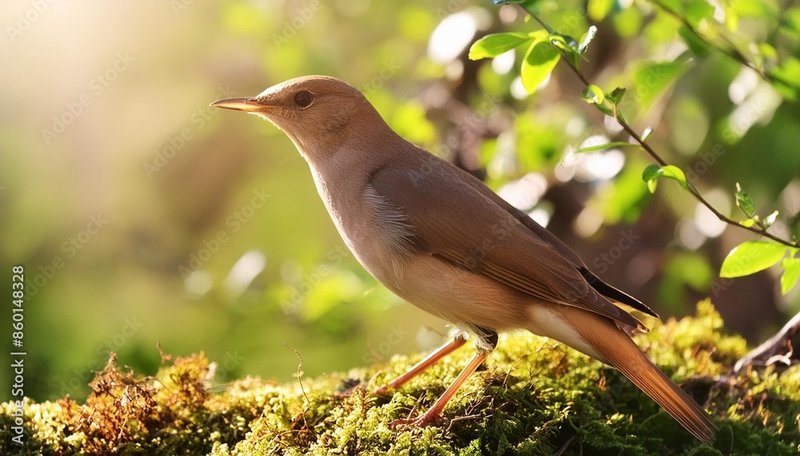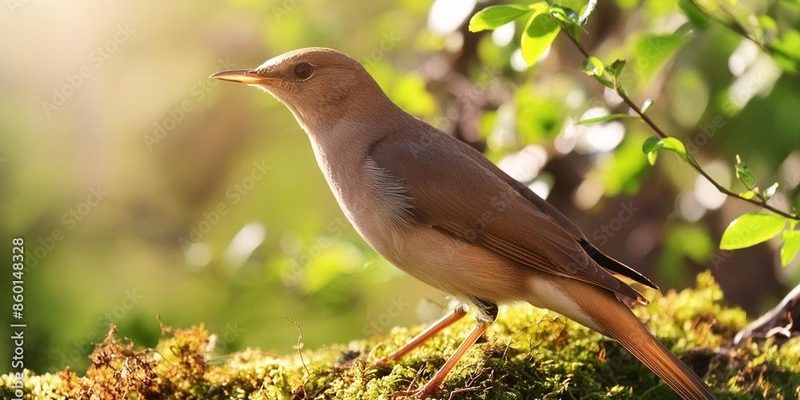
The nightingale is a small bird known for its astonishingly beautiful and complex song. Imagine being serenaded by a bird’s sweet melody while walking through a tranquil forest at dusk—this is the experience many have when they encounter a nightingale in the wild. Their enchanting voices have inspired poets, musicians, and nature lovers for centuries, making them a symbol of love and beauty in various cultures.
But what makes the nightingale so special? It’s not just their hauntingly lovely songs; it’s also their fascinating behavior and lifestyle. From their unique migration patterns to their choice of habitats, nightingales embody the wonders of the natural world. In this article, we’ll explore everything from what these remarkable birds eat to how they communicate, helping you appreciate the nightingale like never before.
Physical Characteristics
Nightingales are petite birds, measuring about 6 to 7 inches long and weighing around 1 ounce. Their plumage is generally a mix of browns and grays, which makes them blend seamlessly into their surroundings. You might not notice them at first glance, as their understated coloring serves as excellent camouflage. However, their distinctive features are best observed during the breeding season when males can be seen performing their vibrant displays.
The male nightingale is particularly striking during this time, puffing out its chest and spreading its wings while singing to attract a mate. The song, a medley of trills and whistles, can be heard during the day but is most prominent at night—hence their name. The females, while less flamboyant, are equally enchanting with their softer, more subdued tones.
| Size: | 6-7 inches |
| Weight: | 1 ounce |
| Habitat: | Woodlands, gardens, and scrublands |
| Diet: | Insects, berries, and seeds |
| Song: | Melodic and varied |
| Lifespan: | 2-5 years in the wild |
Habitat and Distribution
Nightingales primarily inhabit Europe, parts of Asia, and North Africa. They prefer thick underbrush in woodlands and gardens, where they can easily hide from predators. Their choice of habitat is crucial for both their survival and their melodious performances. Dense vegetation helps them feel secure while singing and searching for food.
During the breeding season, nightingales are known to migrate from southern regions to northern areas, traveling thousands of miles to find the perfect nesting grounds. In Europe, they typically arrive in March or April, eagerly setting up their territories to attract mates. As summer ends, they’ll begin their return journey to warmer climates, where they seek refuge from the harsh winter months.
Interestingly, nightingales are somewhat adaptable. While they thrive in dense forests, they can also be found in urban gardens, provided there’s enough foliage. This adaptability poses a question: how do they navigate their way back home each year? Their migratory patterns are believed to be guided by a combination of instinct, geography, and changes in environmental cues.
Diet and Feeding Habits
The nightingale’s diet is diverse and varies depending on the season. During spring and summer, when insects are abundant, they feast on a variety of small invertebrates. This includes caterpillars, beetles, and spiders, which are vital for feeding their growing chicks. As fall approaches and insects become scarce, nightingales switch to berries and seeds, adapting to the changing availability of food sources.
What’s fascinating is their foraging behavior. Nightingales often search for food on the ground, using their sharp bills to probe through leaf litter and soil. They have a keen sense of hearing, allowing them to detect the slightest movements of insects hidden beneath the surface. This skill is not just impressive; it’s essential for hunting down their next meal.
In addition to their foraging techniques, nightingales are also known for their social feeding habits. They often gather in small groups, taking advantage of each other’s vigilance to spot potential threats. This collective behavior not only increases their chances of finding food but also enhances their safety from predators lurking nearby.
Behavior and Communication
Nightingales are famously known for their extraordinary singing abilities. Their songs are not merely for show; they serve a crucial purpose in communication. Males use their songs to establish territories, attract mates, and ward off rivals. The complexity and richness of their tunes can vary significantly among individuals, making each nightingale’s song unique.
Interestingly, nightingales are also known to mimic the songs of other birds. This mimicry can create a diverse soundscape that further enhances their appeal during the mating season. Imagine a nightingale blending its beautiful melody with the calls of other birds—it’s a symphony of nature that captivates all who hear it.
While they are primarily nocturnal singers, nightingales can also communicate through visual displays. During courtship, males perform elaborate displays involving wing flapping and changes in posture, showcasing their physical fitness to potential mates. This combination of vocal and non-vocal communication highlights their adaptability and intelligence.
Breeding and Nesting
The breeding season for nightingales typically begins in late April and lasts until early summer. During this time, males are particularly active in defending their territories and singing to attract females. Once a female chooses her mate, they will begin the process of nesting together. Nightingales typically build their nests close to the ground, often in dense vegetation, where they can blend in and stay hidden from predators.
The nest itself is a remarkable structure, crafted from twigs, grass, and leaves, lined with softer materials to keep the eggs warm. A female nightingale usually lays about four to six eggs, which she incubates for around two weeks. After hatching, both parents are involved in feeding the chicks, bringing a steady supply of insects and berries until the fledglings are ready to take their first flights.
Once the young nightingales leave the nest, they are not immediately independent. They remain in the vicinity, learning to forage and honing their singing skills under the watchful eyes of their parents. This extended period of care is essential for their survival, as fledglings need time to develop the skills needed to thrive on their own.
Conservation Status
Despite their reputation as a beloved songbird, nightingale populations have faced significant challenges in recent years. Habitat loss due to urbanization, agriculture, and deforestation has taken a toll on their natural environments. As their habitats disappear, so do the opportunities for them to breed and find food, leading to declines in their populations.
Conservation efforts are crucial to protecting these enchanting birds. Initiatives focused on habitat restoration, the establishment of protected areas, and public awareness campaigns can help create safe environments for nightingales to thrive. Engaging local communities in conservation activities not only raises awareness but also fosters a connection between people and nature.
Furthermore, the nightingale’s status as a symbol of beauty and love in literature and culture can play an essential role in conservation. By highlighting their importance through storytelling and advocacy, we can inspire action to protect this melodic bird and its habitat. After all, preserving the nightingale means preserving a piece of our natural heritage.
FAQ
What is a nightingale’s song like?
The nightingale’s song is often described as one of the most beautiful in the bird world. It features a rich variety of notes, trills, and whistles, with the male often singing at night, particularly during the breeding season. Each song can last several minutes, showcasing their remarkable vocal abilities and individuality.
Where do nightingales migrate?
Nightingales are migratory birds, often traveling from their wintering grounds in Africa and southern regions to breeding sites in Europe and parts of Asia. They typically return to their nesting areas in March or April, navigating through various landscapes to find their way back home.
What do nightingales eat?
The diet of nightingales consists mainly of insects, berries, and seeds. During the summer months, they primarily hunt insects to provide protein for their growing chicks. In the autumn, they switch to fruits and seeds, adapting to the seasonal availability of food.
Are nightingales social birds?
While nightingales are generally solitary outside the breeding season, they can exhibit social behavior during foraging. They may gather in small groups to feed, taking advantage of each other’s vigilance to stay safe from predators and to maximize their chances of finding food.
How do nightingales communicate?
Nightingales communicate primarily through their beautiful songs, which serve to establish territory and attract mates. They also engage in visual displays during courtship. Interestingly, they can mimic the songs of other birds, adding to their vocal repertoire and enhancing their chances of attracting partners.
How long do nightingales live?
In the wild, nightingales typically live for about 2 to 5 years. However, some individuals may live longer, especially in areas where they have access to abundant resources and minimal threats. Survival rates can vary based on environmental conditions and human activity.
What is the significance of nightingales in culture?
Nightingales hold a special place in various cultures and literatures, often symbolizing love, beauty, and poetic inspiration. Poets and musicians alike have drawn inspiration from their songs, leading to their portrayal in countless works throughout history. This cultural significance contributes to ongoing efforts to protect and preserve their habitats.
Can you attract nightingales to your garden?
Yes, you can attract nightingales to your garden by creating a suitable habitat. Planting dense shrubs and trees, providing water sources, and leaving natural spaces for insects to thrive can create an inviting environment. Avoiding pesticides will also help, as nightingales rely on healthy insect populations for food.
Do nightingales have any natural predators?
Nightingales face various natural predators, including birds of prey such as hawks and owls. Additionally, mammals like cats and snakes can pose a threat, especially to their nests and young chicks. Their camouflage helps them evade detection, but they must always be vigilant in their surroundings.

